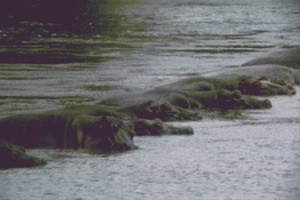
This National Park (140 000 acres) extends 23.6 miles west- wards along the Zambezi River from the Victoria Falls and southwards for up to 15 miles. It has good populations of most indigenous mammals and birds and provides a convenient wildlife viewing area for tourists based at the Falls.
On the northern boundary of the park the Zambezi River has formed several rapids in the basaltic rock over which it flows. It is flanked by a strip of riverine woodland that consists of such species as ebonies, figs, mangosteens and Acacia albida. Ilala palms are conspicuous in some areas.
Kalahari sand vegetation covers much of the rest of the park, with woodlands in which teak and mukwa feature prominently. Mopane scrub and woodland occur on some areas of shallow basaltic soil.
The park is well known for its fine herds of sable antelopes. Elephant are common and both the black and white rhinoceros, which had become locally extinct, have been reintroduced. Kudu, impala, waterbuck, zebra, lion, leopard and hyaena are plentiful and herds of eland are sometimes sighted.
Cheetah and wild dog are also present. Hippopotamus occur in quieter reaches and backwaters along the Zambezi; and crocodile, once almost exterminated by indiscriminate hunting, have made a strong recovery, largely because of the restocking carried out by the commercial crocodile farms based at the Victoria Falls.
There are two main viewing drives in the park. The Zambezi Drive is entered via a gate close to Victoria Falls town and runs for 23.6 miles along the riverbank. Another entrance gate, 3.7 miles south of the town, provides access to the Chamabonda Drive which follows the course of the Masuie River.
The National Park is also crossed by the main Victoria Falls-Kazungula road. The Department of National Parks maintains attractive guest lodges on the banks of the Zambezi at the eastern end of the park; camping and caravanning facilities are also available.